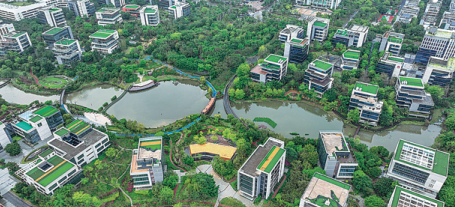With the Regional Comprehensive Economic Partnership agreement and free trade port policies beginning to produce chain-effect benefits in Hainan, China's free trade port is expected to become a trade hub linking the domestic market to the RCEP region and the world market as a whole, said experts and officials.
Data released by Haikou Customs showed that Hainan's import from and export to members of the Association of Southeast Asian Nations increased by 42.1 percent, and its trade with other RCEP member countries increased by 43.4 percent in the first four months of this year.
With implementation of the provisions on liberalization and facilitation in both trade and investment, it is widely expected that the RCEP pact, together with the Hainan FTP policies, will generate a superimposed effect in stimulating more opening-up dividends that ensure bright prospects for investors in Hainan, said experts at a recent forum held in Haikou, the provincial capital.
The RCEP agreement, so far the world's biggest trade pact signed in November by 15 Asia-Pacific countries, including all 10 ASEAN member states 2020, came into effect at the start of the year. Up to now, the agreement is effective for 13 of its 15 signing members.
Since the release of a master plan for the construction of the Hainan FTP in June 2020, a slew of policies and measures have been rolled out to liberalize and facilitate trade in goods and services, secure wider market access to sectors including finance, culture and medical care in a bid to make the Hainan FTP a highland showcasing the nation's economic reform and opening-up.
Wang Bin, head of the Publicity Department of the CPC Hainan Provincial Committee, said the province will grasp the opportunities presented by the RCEP implementation, to better engage in the dual-circulation development pattern, improve resource allocation and enhance its opening-up.
Although there will be challenges and uncertainties ahead, such as the impact of the COVID-19 pandemic, the implementation of the RCEP agreement will create more opportunities for China, especially the southernmost province of Hainan.
Making good use of its unique geographical advantages, FTP policies and business environment, Hainan will benefit significantly from the RCEP, according to Wu Hailong, president of the China Public Diplomacy Association.
Overseas growth of Hainan companies in recent years has shown that Hainan has the foundation and advantages in closer collaboration with RCEP member countries. And there is ample room for two-way investment, said experts.
"Enforcement of the RCEP pact will reduce the tariff on auto parts. Hainan's unique location and the advantages of Hainan FTP policies will remarkably reduce the costs in purchase, production and circulation of auto parts for Haima in the RCEP region," said Dong Guoqiang, deputy general manager of Hainan Haima Automobile. Haima's export volume to the Southeast Asian market reached 600 million yuan ($90.03 million) in 2021, a year-on-year increase of 20 percent and the company will seize the opportunity to expand the Southeast Asian market, Dong added.
The Hainan provincial government has released 20 measures to help domestic and foreign enterprises better benefit from and better cope with the new opportunities and challenges brought by the RCEP for the construction of Hainan free trade port, according to officials with the provincial department of commerce.
The measures are expected to optimize the early policy and institutional arrangements of the Hainan FTP, boost two-way trade and investment, strengthen intellectual property protection, and improve services that support implementation of the RCEP pact.
Chi Fulin, president of China Institute for Reform and Development and head of the Hainan Institute for Free Trade Port Studies, said that Hainan has become the only region in China that enjoys "zero tariff" arrangements in the ternary supply chain that covers the domestic supply chain, RCEP regional supply chain and extra-regional supply chain.
The RCEP pact will strengthen Hainan's regional advantages and provide an opportunity for the Hainan FTP to build an ASEAN-oriented industrial chain and supply chain.
"The RCEP will drive the regional flow of people, logistics, capital and information," said Yu Tao, director of the Hainan FTP research center under the South China Sea Research Institute.
He said that geographical advantages will help Hainan to become a regional aviation and maritime hub. He believes that enforcement of the RCEP pact can promote cooperation between Hainan and ASEAN members in areas such as blue carbon, marine environmental protection and maritime search and rescue.
Yu's views were echoed online by Ong Tee Keat, a former minister of transport of Malaysia and currently president of the country's Center for New Inclusive Asia, at a recent forum. Ong said that he has seen complementarity between Hainan and Southeast Asian economies in areas of the green and blue economies, such as trade in carbon credits, aquaculture, fisheries and maritime logistics. He took a rosy view of the development prospects of the cooperation between Hainan and Southeast Asian countries under the RCEP framework.
Co-initiated by 17 think tanks in nine Asian countries, the ASEAN-Hainan Free Trade Port Think Tank Network was established on April 21 during the Boao Forum for Asia 2022 Annual Conference.
The network aims to play a positive role in promoting comprehensive cooperation, and economic and trade cooperation, as well as people-to-people exchanges between ASEAN and China by holding forums and activities and developing information sharing platforms, according to the China (Hainan) Reform and Development Research Institute, which has jointly launched the new organization.

An aerial view of the Hainan Resort Software Community, one of the key industrial parks of Hainan free trade port. ZHANG MAO/FOR CHINA DAILY